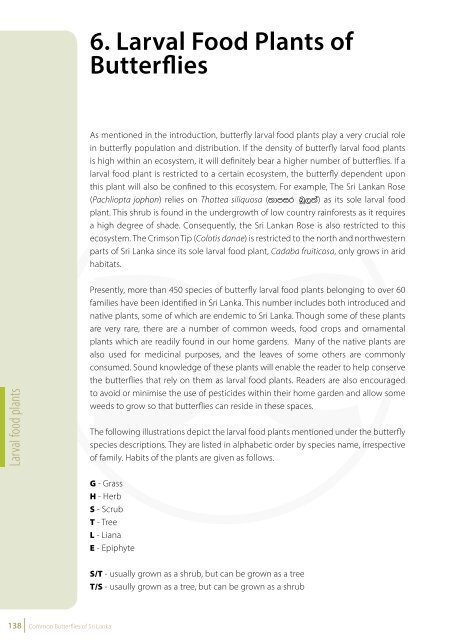Common Butterflies of Sri Lanka
Common Butterflies of Sri Lanka
Common Butterflies of Sri Lanka
Create successful ePaper yourself
Turn your PDF publications into a flip-book with our unique Google optimized e-Paper software.
6. Larval Food Plants <strong>of</strong><br />
<strong>Butterflies</strong><br />
As mentioned in the introduction, butterfly larval food plants play a very crucial role<br />
in butterfly population and distribution. If the density <strong>of</strong> butterfly larval food plants<br />
is high within an ecosystem, it will definitely bear a higher number <strong>of</strong> butterflies. If a<br />
larval food plant is restricted to a certain ecosystem, the butterfly dependent upon<br />
this plant will also be confined to this ecosystem. For example, The <strong>Sri</strong> <strong>Lanka</strong>n Rose<br />
(Pachliopta jophon) relies on Thottea siliquosa (;dmir nq,;a) as its sole larval food<br />
plant. This shrub is found in the undergrowth <strong>of</strong> low country rainforests as it requires<br />
a high degree <strong>of</strong> shade. Consequently, the <strong>Sri</strong> <strong>Lanka</strong>n Rose is also restricted to this<br />
ecosystem. The Crimson Tip (Colotis danae) is restricted to the north and northwestern<br />
parts <strong>of</strong> <strong>Sri</strong> <strong>Lanka</strong> since its sole larval food plant, Cadaba fruiticosa, only grows in arid<br />
habitats.<br />
Abrus precatorius T,s|<br />
L<br />
Acacia caesia ys.=re je,a<br />
L/S<br />
Larval food plants<br />
Presently, more than 450 species <strong>of</strong> butterfly larval food plants belonging to over 60<br />
families have been identified in <strong>Sri</strong> <strong>Lanka</strong>. This number includes both introduced and<br />
native plants, some <strong>of</strong> which are endemic to <strong>Sri</strong> <strong>Lanka</strong>. Though some <strong>of</strong> these plants<br />
are very rare, there are a number <strong>of</strong> common weeds, food crops and ornamental<br />
plants which are readily found in our home gardens. Many <strong>of</strong> the native plants are<br />
also used for medicinal purposes, and the leaves <strong>of</strong> some others are commonly<br />
consumed. Sound knowledge <strong>of</strong> these plants will enable the reader to help conserve<br />
the butterflies that rely on them as larval food plants. Readers are also encouraged<br />
to avoid or minimise the use <strong>of</strong> pesticides within their home garden and allow some<br />
weeds to grow so that butterflies can reside in these spaces.<br />
The following illustrations depict the larval food plants mentioned under the butterfly<br />
species descriptions. They are listed in alphabetic order by species name, irrespective<br />
<strong>of</strong> family. Habits <strong>of</strong> the plants are given as follows.<br />
Acacia eburnea l=l=,a lgq<br />
S<br />
Acacia pennata f.dv ysÕ=re<br />
L/S<br />
Larval food plants<br />
G - Grass<br />
H - Herb<br />
S - Scrub<br />
T - Tree<br />
L - Liana<br />
E - Epiphyte<br />
S/T - usually grown as a shrub, but can be grown as a tree<br />
T/S - usaully grown as a tree, but can be grown as a shrub<br />
Actinodaphne stenophylla ksl ojq, S/T Aeschynomene americana H<br />
138 <strong>Common</strong> <strong>Butterflies</strong> <strong>of</strong> <strong>Sri</strong> <strong>Lanka</strong><br />
<strong>Common</strong> <strong>Butterflies</strong> <strong>of</strong> <strong>Sri</strong> <strong>Lanka</strong> 139















